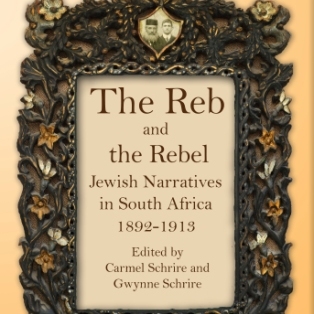BRIAN JOSSELOWITZ
PHOTOGRAPHS: UCTPRESS/JUTA
Pictured : The cover of the book: “The Reb and the Rebel, Jewish Narratives in South Africa 1892-1913”.
The Reb and the Rebel, (UCTPress/Juta), is a fascinating insight into life in Cape Town and Johannesburg by Reb Yehuda Leib Schrire (1851-1912) who was a cantor and a shochet.
He arrived in Johannesburg from Lithuania in 1892 and in his diary describes his journey from his birthplace, Oshmanye, through Germany, Holland, the Canary Islands to his arrival in Cape Town on the Dunbar Castle and then on to Johannesburg.
His description of the long trip is so lively that you feel you are on the ship, on the train and on the mule cart with him.
The book consists of three manuscripts: a diary and a poem, titled Tolada (history) by Yehuda ben Leib Schrire and the memoirs of the Rebel, the District 6-born Harry Nathan Schrire (1895-1980).
Robins had the copy of her Uncle Harry’s memoirs which she had wanted to publish for 40 years and her cousin, Carmel, a PhD and professor at Rutgers, had the diary and the poem, which she found when her mother directed her to the “big cupboard”.
Carmel, who is a regular lecturer at UCT, got UCTPress/Juta interested in publishing the book and they sent it to various readers to be vetted, said Robins.
“Editing the poem and the poem footnotes was the most difficult part of the book. Carmel insisted on this as it was written in biblical Hebrew before Ben Yehuda had developed it into a modern language and Carmel wanted to know where the words and phrases had come from. When the poem, Tolada, had been translated, Carmel said she had a handwritten diary but the Kaplan Centre had no more money for the project,” Robins recounts.
When Robins went to visit one of her mother’s best friends, then terminally ill, the woman’s Israeli daughter from America was there and she offered to translate the diary as it would give her something to do.
“So every night I would go there and she would tell me what the diary said; I wrote it down and at home put it on the computer and tidy the language. Then the woman died and I never thought the book would be completed. But when I went for prayers, the daughter-in-law afterwards took me into the bedroom and finished the translation.
“Uncovering the diary was so exciting because it is the oldest such manuscript we have about Jewish travels and Jewish Johannesburg, and the book’s publication is a dream come true,” said Robins.
Michaelis Professor of Art, Pippa Skotness, did the design for the book cover. The picture is of one of Yehuda Leib’s woodcuts, designed to mourn his daughter- in- law’s mother, Mauerberger and the bird with the five eggs at the bottom represent her and her five children. Skotness inserted the photographs at the top.





